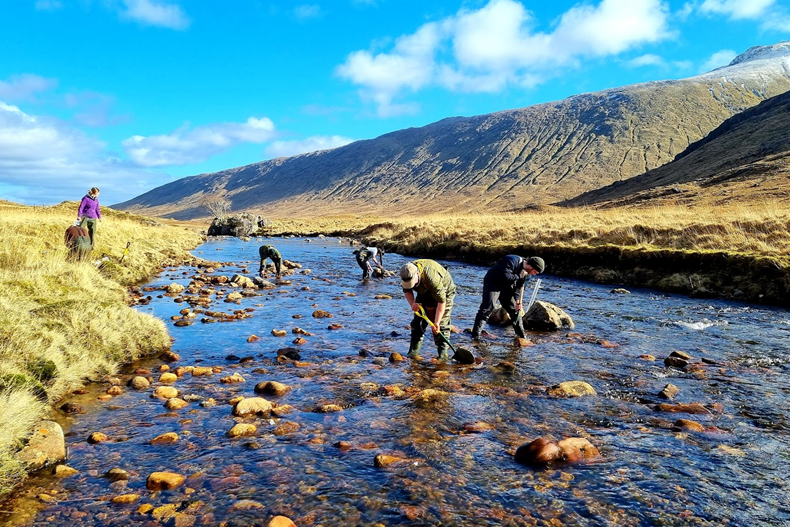SSE Renewables funded Upper Garry Salmon Restoration Project achieves major milestone

One million salmon eggs have now been distributed in the River Garry
The Upper Garry Salmon Restoration Project, a project funded by SSE Renewables, has reached a significant milestone with one million salmon eggs now distributed or laid in the River Garry.
The ground-breaking initiative was developed to help kickstart the revival of wild salmon in what was once one of Scotland’s most productive early salmon fisheries.
Over many decades the salmon population, and consequently salmon catches, in the River Garry, at the south-west end of the Ness catchment where salmon migration is impacted by hydro dams, have fallen dramatically and it became ever more evident that numbers in the upper part of the river were critically low and close to the point of no return.
"The Board, as custodians of the Ness’s salmon, was faced with a stark choice – either to allow an important element of the Ness system’s salmon to become extinct or come up with an innovative restoration project. Fortunately, my predecessor had the foresight, in conjunction with SSE and the University of the Highlands and Islands, to design such an appropriately ambitious project.
BRIAN SHAWDIRECTOR OF THE NESS DISTRICT SALMON FISHERY BOARD
We have now introduced a million salmon eggs, a landmark figure, to the Upper Garry tributaries and it is particularly pleasing that a decade of hard work is now paying off, not only with increasing numbers of juvenile salmon close to where the eggs were planted out but also with tangible early signs of higher numbers of adult salmon returning to the Garry and its upper reaches."
Due to the fragile nature of the Upper Garry salmon stocks the project adopted a novel approach to build up the number of salmon eggs available for stocking. Salmon smolts, young salmon which leave the spawning rivers in the spring to begin their journey to the sea, were trapped as they left the River Garry and then grown on in freshwater. Smolts are adapted to life in saltwater so growing them on in freshwater to maturity (when their eggs could be stripped) is challenging but with the expertise of Jon Gibb and his team at Drimsallie Hatchery, Glenfinnan, the first eggs for stocking out in the Upper Garry were produced in 2018. The number of eggs produced and stocked out each year has increased as husbandry techniques were refined.
Brian Shaw continued: “One of the most pleasing aspects of the project has been the close collaboration between the project partners. All are agreed that it is futile to dwell on the mistakes of the past. To tackle this decline in salmon numbers the Ness Board with its partners including SSE Renewables, University of Highlands and Islands, Mowi, SEPA and Garry Fishings have come together to ensure the delivery of a project to restore a wild salmon population to the Upper River Garry. Whilst, given the myriad of problems faced by wild salmon, restoring the Garry to its former glory is somewhat unlikely, this project is already bearing fruit in terms of kickstarting a viable self-sustainable population.”
"The Upper Garry Salmon Restoration Project is a fine example of stakeholder collaboration and an innovative approach to environmental management. It is great to see that the one millionth egg has been planted out into the upper River Garry this year and is testament to all the hard work that has put into the project over a number of years. Salmon populations are reaching crisis levels in many of Scotland’s rivers due to a wide range of pressures.
ANDY JACOBSSSE RENEWABLES HYDRO OPERATIONS ENVIRONMENT MANAGER
At SSE Renewables we continue to strive to protect and enhance the natural environment in order to mitigate for any ongoing impacts which may be related to the operations of our hydro fleet and this project is another fine example of that. The real benefits of the project, essentially an increase in returning adult salmon numbers, should begin to be seen over the next couple of years, which will include environmental improvements, an increase in biodiversity but will also help support the local economy and communities throughout the wider River Ness catchment."
In addition to the stocking of salmon eggs the project has also prompted a new approach to management of the salmon smolts as they pass downstream through Loch Garry Dam. Following extensive research and monitoring to demonstrate and justify changes to the operational set up, smolt screens were removed and the smolts allowed to exit Loch Garry via the hydro generation tunnel. Experience elsewhere in the SSE network had shown that allowing smolts to exit this way results in increased survival and significant increases in the number of adults returning.
"We have been delighted to be part of this ground-breaking project to restore the River Garry’s salmon. The team here at Drimsallie Hatchery and Live Salmon Gene Bank believe that the use of targeted restocking projects can in some instances be part of measures we can take to save the Atlantic salmon from extinction. We are very encouraged to see some early positive signs from this project and we will be watching progress closely over the next few years to see if wild Atlantic salmon will once again repopulate this wonderful Highland river."
JON GIBBDRIMSALLIE HATCHERY MANAGER
